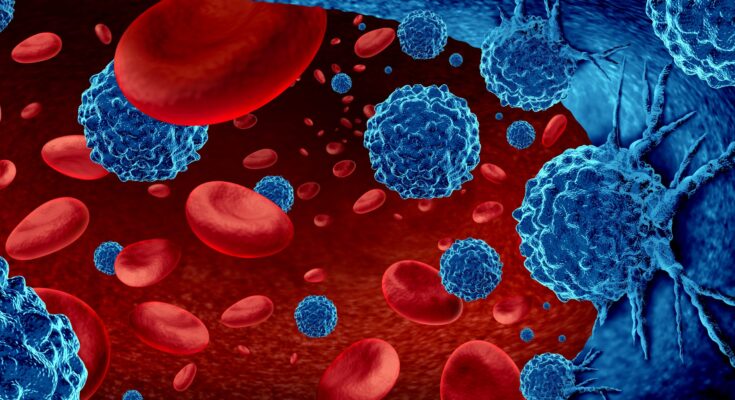Lymphoma Symptoms: Lymphoma represents one of the most prevalent types of cancer, affecting the lymphatic system, which plays a crucial role in the immune function and fluid balance of the body.
This condition is primarily characterized by the formation of abnormal lymphocytes, a type of white blood cell pivotal to the immune response.
Understanding the symptoms and causes of lymphoma is essential for early detection and effective treatment.
What is Lymphoma?
Lymphoma is a type of cancer that originates in the lymphatic system, which is a crucial part of the body’s immune defense. This system includes the lymph nodes, spleen, thymus gland, and bone marrow. Lymphoma occurs when lymphocytes, a type of white blood cell that fights infection, begin to mutate and grow uncontrollably. These cancerous cells can then spread to different parts of the lymphatic system and beyond.
Types of Lymphoma
Lymphoma is primarily classified into two main types: Hodgkin lymphoma and non-Hodgkin lymphoma.
- Hodgkin Lymphoma: This type is distinguished by the presence of Reed-Sternberg cells, a specific type of abnormal lymphocyte. Hodgkin lymphoma is generally considered rare and accounts for about 10% of all lymphoma cases. It typically has a high survival rate, especially when diagnosed early.
- Non-Hodgkin Lymphoma (NHL): More common than Hodgkin lymphoma, NHL encompasses a diverse group of diseases that vary significantly in their severity—from very aggressive to very slow growing. NHL does not feature Reed-Sternberg cells, which helps in differentiating it from Hodgkin lymphoma.
Incidence Rates of Lymphoma
Lymphoma represents a significant health issue worldwide, with incidence rates that emphasize its relevance. According to recent statistics:
- Approximately 83,000 new cases of lymphoma are diagnosed in the United States each year.
- Globally, lymphoma accounts for about 3% of all cancer cases, affecting millions of individuals.
- Non-Hodgkin lymphoma is more prevalent than Hodgkin lymphoma, with NHL cases making up approximately 90% of all lymphoma diagnoses.
However, understanding lymphoma’s impact helps in recognizing the importance of research, early diagnosis, and effective treatment strategies to combat this diverse group of diseases.
Symptoms of Lymphoma
Recognizing these symptoms early can be crucial for timely diagnosis and treatment. This article will explore the early and advanced symptoms of lymphoma to aid in awareness and prompt medical consultation.
Early Signs and Symptoms of Lymphoma
The early signs of lymphoma are often subtle and can easily be mistaken for less serious illnesses. However, being aware of these can help in detecting the disease at an initial stage, which is often associated with better treatment outcomes. Key early symptoms include:
- Swollen Lymph Nodes: One of the most common early signs are painless swellings in the lymph nodes in the neck, armpits, or groin.
- Fever: An unexplained fever that does not go away might signal something more serious, like lymphoma.
- Night Sweats: Experiencing severe, drenching night sweats can be a prominent early symptom.
- Weight Loss: Losing weight without a change in diet or exercise routine is another significant early symptom.
- Fatigue: Persistent tiredness or feeling of lethargy that doesn’t improve with rest can also be indicative of lymphoma.
- Itchiness: Unexplained itchiness all over the body without an apparent cause or rash.
These symptoms can often be confused with common viral infections, which is why they may not initially be linked to lymphoma.
Advanced Symptoms of Lymphoma
As lymphoma progresses, the symptoms typically become more severe and distinct. Recognizing these advanced symptoms can prompt urgent medical evaluation and care:
- Enlargement of Lymph Nodes: While lymph node swelling is also an early sign, in advanced lymphoma, the nodes may become more prominent and persistent.
- Increased Fatigue: The fatigue experienced in advanced stages can be debilitating and significantly affect daily activities.
- Severe Night Sweats and Fever: At advanced stages, night sweats and fevers become more frequent and intense.
- Abdominal Pain or Swelling: Enlargement of the spleen or liver due to lymphoma can cause abdominal pain or a feeling of fullness.
- Breathing Difficulties or Cough: If lymphoma affects the lymph nodes in the chest, it can lead to coughing or trouble breathing.
- Unexplained Anemia: A decline in red blood cells causing weakness, dizziness, or shortness of breath can occur.
- Frequent Infections: As the immune system becomes compromised, there may be an increase in the frequency or severity of infections.
If you or someone you know is experiencing multiple symptoms listed above, it is advisable to consult a healthcare professional for an accurate diagnosis and appropriate management. Early detection remains a critical factor in the effective treatment of lymphoma.
Causes and Risk Factors of Lymphoma
Understanding the causes and risk factors of lymphoma can help in early detection and prevention. Lymphoma, a type of cancer that originates in the lymphatic system, involves the abnormal proliferation of lymphocytes, a type of white blood cell. While the exact causes of lymphoma remain unclear, extensive research has identified several risk factors that increase the likelihood of developing this disease.
Causes of Lymphoma
Lymphoma does not have a single, well-defined cause; however, several factors are known to trigger the abnormal growth of lymphocytes. These include:
- Genetic Mutations: Changes in the DNA of lymphocytes can lead to malignant transformation.
- Viral Infections: Certain viruses, such as the Epstein-Barr virus (associated with mononucleosis), are linked to the development of lymphoma.
- Immune System Deficiency: Individuals with weakened immune systems, whether from inherited conditions or diseases like HIV/AIDS, are at a higher risk.
- Autoimmune Diseases: Conditions like rheumatoid arthritis and Sjögren’s syndrome can increase the risk due to chronic immune system stimulation.
List of Risk Factors for Lymphoma
Several factors may not cause lymphoma directly but are considered significant risk factors:
- Age: Although lymphoma can occur at any age, some types are more common in older adults.
- Sex: Certain types of lymphoma are more prevalent in one sex than the other. For example, Hodgkin lymphoma is generally more common in males.
- Family History: Having a close family member with lymphoma increases an individual’s risk.
- Exposure to Chemicals: Exposure to certain chemicals, such as benzene and some pesticides, has been linked to a higher risk of developing lymphoma.
- Radiation Exposure: Individuals exposed to high levels of radiation, either from radiation therapy for another cancer or from environmental sources, may have an increased risk of lymphoma.
Research Findings on the Etiology of Lymphoma
Research into the etiology of lymphoma has made significant progress over the years. Studies have shown that both genetic and environmental factors play crucial roles in the development of lymphoma. Genetic research has uncovered specific mutations that can predispose individuals to lymphoma. Additionally, environmental studies have identified factors such as infectious agents and toxic chemical exposure that contribute to the risk.
Epidemiological studies continue to explore how lifestyle factors like diet, exercise, and exposure to pollutants play into the risk equation. This ongoing research is critical for developing targeted prevention strategies and enhancing our understanding of lymphoma’s complex etiology.
Diagnosing Lymphoma
Understanding the various diagnostic methods and the pivotal role of biopsy can aid patients and healthcare providers in managing this complex condition effectively. Here’s a detailed look at the diagnostic procedures for lymphoma.
List of Diagnostic Methods
- Physical Examination: Doctors start with a thorough physical exam, including checking for swollen lymph nodes in the neck, underarms, and groin.
- Blood Tests: These can help identify abnormal levels of certain substances in the blood that suggest lymphoma.
- Imaging Tests: Imaging modalities such as X-rays, CT scans, PET scans, and MRI are used to visualize areas of lymphoma throughout the body.
- Lymph Node Biopsy: This is the definitive test for diagnosing lymphoma. A sample of lymph node tissue is removed and examined under a microscope to detect lymphoma cells.
- Bone Marrow Biopsy: This test involves taking a sample from the bone marrow to look for lymphoma cells, which can indicate whether the cancer has spread.
- Lumbar Puncture (Spinal Tap): This procedure checks for the presence of lymphoma cells in the cerebrospinal fluid.
Role of Biopsy in Confirming Lymphoma
The biopsy, particularly of the lymph node, plays a critical role in confirming the diagnosis of lymphoma. It allows pathologists to observe the cells directly and determine the specific type of lymphoma, which is crucial for outlining the appropriate treatment strategy. There are different types of biopsies:
- Excisional Biopsy: The entire lymph node is removed for thorough examination.
- Incisional Biopsy: Only a part of the lymph node or a suspicious area is removed.
- Core Needle Biopsy: A needle is used to extract tissue samples from the lymph node.
Importance of Early and Accurate Diagnosis for Treatment Effectiveness
Early and accurate diagnosis of lymphoma is vital for several reasons:
- Treatment Planning: Identifying the type of lymphoma and its stage helps in selecting the most effective treatment plan.
- Prognosis: Early diagnosis generally leads to a better prognosis as treatments can be more effective when started early.
- Preventing Spread: Timely diagnosis can help prevent the spread of lymphoma to other parts of the body, which is crucial for the patient’s overall health and recovery.
However, patients are encouraged to consult with their healthcare provider if they experience symptoms suggestive of lymphoma to ensure timely and effective management of the disease.
Comprehensive List of Lymphoma Treatment Methods
Lymphoma, a type of cancer that affects the lymphatic system, has various treatment methods that are chosen based on the specific type of lymphoma, its stage, and the patient’s overall health. Here’s a comprehensive guide to the primary treatment options available for lymphoma:
1. Chemotherapy: This is a common treatment for lymphoma and involves using drugs to kill cancer cells or stop them from growing. It can be administered orally or intravenously and is often used in combination with other treatments.
2. Radiation Therapy: Radiation therapy uses high-energy rays (similar to X-rays) to target and kill cancer cells. It is often used for localized lymphoma, where cancer is contained in one area.
3. Immunotherapy: This treatment boosts the body’s natural defenses to fight the cancer. It uses substances made by the body or in a laboratory to improve or restore immune system function.
4. Targeted Therapy: Targeted therapy focuses on specific elements that are unique to cancer cells. These drugs or other substances interfere with cancer cell growth and survival.
5. Stem Cell Transplant: This procedure involves replacing diseased bone marrow with healthy stem cells. It can be autologous (using the patient’s own stem cells) or allogeneic (using stem cells from a donor).
6. Surgery: In some cases, surgery may be used to remove a part of an enlarged lymph node or an entire lymph node for diagnostic or treatment purposes.
7. Watchful Waiting: For slow-growing types of lymphoma, doctors may recommend monitoring the condition closely without immediate treatment.
However, consulting with a team of healthcare professionals who specialize in lymphoma is crucial to determining the most effective treatment plan tailored to an individual’s needs.
FAQs about Lymphoma Symptoms
What are the common symptoms of lymphoma?
Lymphoma often presents with several noticeable symptoms. The most common include painless swelling of lymph nodes in the neck, armpits, or groin. Many people also experience fever, night sweats, unexplained weight loss, fatigue, and a persistent feeling of tiredness.
Can lymphoma symptoms be mistaken for other conditions?
Yes, symptoms of lymphoma such as swollen lymph nodes, fatigue, and fever can be similar to those of less serious illnesses, like the common cold or flu. However, if these symptoms persist or are accompanied by significant weight loss or drenching night sweats, it’s important to consult a healthcare provider for a thorough evaluation.
How quickly do lymphoma symptoms develop?
The onset of lymphoma symptoms can vary widely. Some individuals may notice rapid symptom development, while in others, the symptoms may appear gradually over several months. Monitoring any ongoing or unusual symptoms is crucial for early diagnosis.
Are there any specific symptoms that are unique to lymphoma?
While no symptoms are entirely unique to lymphoma, certain signs are strongly indicative, especially when they occur together. These include painless lymph node swelling combined with systemic symptoms like fevers, night sweats, and unexplained weight loss.
When should someone seek medical advice for lymphoma symptoms?
Seek medical advice if you notice any of the following: enlarged lymph nodes that do not go away after a few weeks, unexplained weight loss, persistent fatigue, fevers, or night sweats. Early medical consultation can lead to timely diagnosis and better treatment outcomes.
Conclusion
In summary, lymphoma presents a range of symptoms that vary widely but often include swollen lymph nodes, fatigue, unexplained weight loss, fever, and night sweats. The causes of lymphoma are not definitively known, but factors such as genetic predisposition, exposure to certain chemicals, and a compromised immune system are considered significant contributors.
If you or someone you know is experiencing any of the symptoms mentioned, it’s crucial to consult with a healthcare provider. Early diagnosis and treatment can greatly improve the effectiveness of lymphoma management. Remember, your health is important, and addressing concerns early with a professional is the best step toward well-being.
References
For additional information and to validate the details provided about lymphoma symptoms, consider exploring these reputable sources. Each link offers further insights into the symptoms, diagnosis, and treatment options available for lymphoma:
- Mayo Clinic – This comprehensive resource provides detailed information on the types of lymphoma, symptoms, and treatment methodologies. Access their lymphoma section here.
- American Cancer Society – Known for its thorough cancer-related content, the American Cancer Society offers a wide range of materials on lymphoma. You can read more about lymphoma symptoms and treatments by visiting their website here.
- National Cancer Institute – As a part of the U.S. National Institutes of Health, this institute provides up-to-date and research-backed information on all types of cancer, including lymphoma. Their lymphoma guide can be found here.
- Leukemia & Lymphoma Society – This society focuses on blood cancers and provides detailed guides on lymphoma, including symptoms and survivor stories. Their resources can be accessed here.
These links lead to trusted medical resources that are essential for anyone seeking in-depth knowledge about lymphoma symptoms, enhancing both understanding and awareness.



